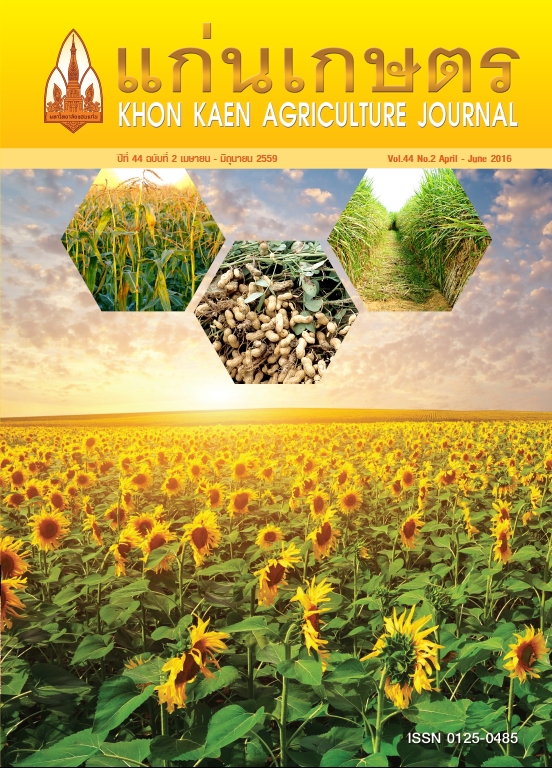การศึกษาพัฒนาขยายปริมาณการติดเชื้อและการผลิตสปอร์เชื้อราเวสสิเคิลอาร์บัสคิวร่าไมคอร์ไรซาในรากหญ้าแฝกและหญ้ารูซี่โดยระบบพ่นหมอก
Main Article Content
บทคัดย่อ
การศึกษาพัฒนาขยายปริมาณการติดเชื้อและการผลิตสปอร์เชื้อราเวสสิเคิลอาร์บัสคิวร่าไมคอร์ไรซา (AMF) ในรากหญ้าแฝกและหญ้ารูซี่ มีวัตถุประสงค์เพื่อเปรียบเทียบการผลิตหัวเชื้อ AMF ในหญ้าแฝกและหญ้ารูซี่ และหากรรมวิธีที่เหมาะสมที่สุดในการผลิตหัวเชื้อ AMF ระหว่างระบบการเพาะแบบพ่นหมอก (aeroponic culture) และระบบการเพาะในกระถาง (pot culture) ใช้แผนการทดลอง factorial in completely randomize design (factorial in CRD) มี 3 ปัจจัย ได้แก่ ปัจจัยแรก คือ วิธีการเพาะเลี้ยงพืช ได้แก่ ระบบการเพาะแบบพ่นหมอก ระบบการเพาะในกระถาง ปัจจัยที่สอง คือ การปลูกเชื้อราไมคอร์ไรซา (+AMF) และไม่ปลูกเชื้อราไมคอร์ไรซา (-AMF) และปัจจัยที่สาม ได้แก่ ชนิดพืชอาศัย 3 ชนิด ได้แก่ ข้าวโพด เป็น positive control; หญ้ารูซี่ และหญ้าแฝก ผลการศึกษา พบว่า หญ้ารูซี่อายุ 3 เดือนที่ปลูกเชื้อรา AMF เพาะเลี้ยงในระบบพ่นหมอก (A+AMF+R) มีอัตราการเจริญเติบโตของเชื้อรา AMF ในรากพืชดีที่สุด (88.0 %) ส่วนความสูงที่ดีที่สุด คือหญ้าแฝกที่ปลูกเชื้อรา AMF ในระบบกระถาง (141.5 เซนติเมตร/ต้น) น้ำหนักรากแห้ง และต้นแห้งที่มากที่สุดคือหญ้ารูซี่ที่ปลูกเชื้อรา AMF ในระบบกระถาง (66.3 และ 146.1 กรัม/กระถาง ตามลำดับ) นอกจากนี้ยังพบว่า หญ้ารูซี่ที่เพาะเลี้ยงในระบบพ่นหมอกมีการเจริญเติบโตที่ตอบสนองต่อเชื้อรา AMF (mycorrhizal responsiveness) ได้ดีเทียบเท่าข้าวโพด (positive control) และการเลี้ยงหญ้ารูซี่ในระบบพ่นหมอกจะเกิดจำนวนสปอร์มากที่สุด
Article Details
เอกสารอ้างอิง
ธงชัย มาลา, วันทนีย์ พึ่งแสง และจีรวัฒน์ พุ่มเพชร. 2546. การคัดเลือกเชื้อราวีเอไมคอร์ไรซาชนิดที่มีประสิทธิภาพสูงในการส่งเสริมการเจริญเติบโตและการติดเชื้อในรากถั่วเหลืองพันธุ์ สจ. 5. วิทยาสารกำแพงแสน. 1: 1-9.
Bolan, N. S. 1991. A critical review on the role of mycorrhizal fungi in the uptake of phosphorus by plants. Plant. Soil. 134: 189-207.
Ceballos, I., M. Ruiz, C. Fernández, R. Peña, A. Rodríguez, and I. R. Sanders. 2013. The in vitro mass-produced model mycorrhizal fungus, Rhizophagus irregularis, significantly increases yields of the globally important food security crop Cassava. PLoS ONE. 8(8): e70633.
Daniels, B. A., and H. D. Skipper. 1982. Method for the recovery and quantitative estimation of propagules from soil. pp. 29-35. In: Methods and Principles of Mycorrhizal Research, N.C. Schenek, eds. The American Phytopathol. Soc. St. Paul, Minnesota.
Hetrick, B. A. D., G. W. T. Wilson, and T. S. Cox. 1992. Mycorrhizal dependence of modern wheat varieties, landraces, and ancestors. Can. J. Bot. 70: 2032-2040.
Hung, L. L. and D. M. Sylvia. 1988. Production of vesicular-arbuscular mycorrhizal fungus inoculum in aeroponic culture. Appl. Environ. Microbiol. 54: 353-357.
Jarstfer, A. G., and D. M. Sylvia. 1995. Aeroponic culture of VAM fungi. P. 427-441. In: A. Varma and B. Hock. Mycorrhiza: structure, function, molecular biology and biotechnology. Springer-Verlag, Berlin.
Mohammad, A., A. G. Khan, and C. Kuek. 2000. Improved aeroponic culture of inocula of arbuscular mycorrhizal fungi. Mycorrhiza. 9: 337-339.
Mosse, B., and J. P. Thompson. 1984. Vesicular-arbuscular endomycorrhizal inoculum production. I. Exploratory experiments with beans (Phaseolus vulgaris) in nutrient flow culture. Can. J. Bot. 62: 1523-1530.
Pawlowska, T. E., D. D. Douds, and I. Charvat. 1999. In vitro propagation and life cycle of the arbuscular mycorrhizal fungus Glomus etunicatum. Mycol. Res. 103: 1549-1556.
Saouy, M., P. Pengchai, and S. Choonluchanon. 2011. Development of arbuscular mycorrhizal spore production in hydroponic culture on lecttuce (Lactuca sativa var crispa L.). CMU. J. Nat. Sci. 10: 147-158.
Sylvia, D. M., and D. H. Hebbel. 1986. Growth and sporulation of vesicular arbuscular mycorrhizal fungi in aeroponic and membrane systems. Symbiosis. 1: 259-267.
Zobel, R. W., P. D. Tredici, and J. G. Torrey. 1976. Methods for growing plants aeroponically. Plant Physiol. 57: 344-346.


